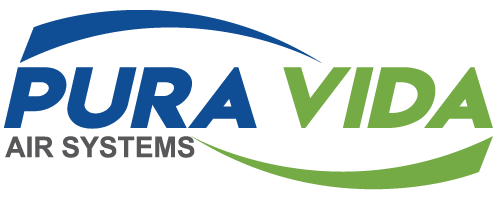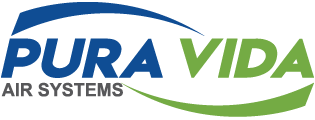Frequently Asked Questions
Photocatalytic Oxidation (PCO) can be defined as a chemical reaction influenced or initiated by light that removes electrons from a catalyst and adds those electrons to a compound. This definition highlights the main ingredients that make photocatalytic air purification possible: a light source, a catalyst, and reactants.1
Simple definition
The series of events following the illumination of a photocatalyst-gas interface may be initiated by either (A) light absorption by the catalyst, which leads to the activation of the reactant, or by (B) direct excitation of the reactant, which is then quenched by the catalyst. Mechanisms (A) and (B) may operate simultaneously at a semiconductor-gas interface, though (A) is generally considered to be the primary step for photocatalytic oxidation.1
Extended definition
An important step of the photoreaction is the formation of electron-hole pairs. These are created when energy is provided to overcome the atomic band gap, between valence band (VB) and conduction band (CB). When a photon, with excitation energy (hu) greater than the band gap energy (EBG), is absorbed an electron hole pair is created.2
Equation 1
(photocatalyst + hⱱ A e- + h+)
The charge is transferred between the electron-hole pairs and an adsorbed, ground state reactant on the photocatalyst surface. Resulting in the photo-oxidation and photo-reduction of reactants.
To what extent electron-hole pairs play a part in the destruction of pollutants is still debated. They may be too short-lived to be able to react directly unless the concentration of the pollutant is high or is strongly adsorbed.
With the presence of water, as vapor forms in the air, the oxidizing agents known as reactive oxygen species (ROS) can be formed. These include oxygen (O2), superoxide (O2-), peroxide (O2-2), and hydroxide (OH). These species can participate in a host of oxidation-reduction (redox) reactions, which are highly effective at the chemical destruction of VOC’s, particulate matter, microbes, ozone, NOx, and SOx. The creation of hydroxyl radicals from water and subsequent destruction of an organic compound are shown in equations 2 and 3. It is shown that, as with e-h pair oxidation, the final products of organic compound oxidation are water and carbon dioxide.
Equation 2
H2O+ h+ A •OH + H+
Equation 3
•OH O2 + CnOmH(2 m-4n=5) → nCO2 + (m – 2n+3) H2O
1 Are all PCO systems the same? No. Although we use a pure TIO2 catalyst, many manufacturers use a doped catalyst to generate a desired Reactive Oxygen Species (ROS) byproduct to be carried into the airstream. Many PCO catalyst systems are improperly illuminated, or the catalyst design itself can contribute to the production of intermediaries as seen in figures 2 & 3 in an experimental honeycomb monolith catalyst.3
Reactive oxygen species are generated as by-products during mitochondrial electron transport. In addition, ROS are formed as necessary intermediates of metal catalyzed oxidation reactions. Atomic oxygen has two unpaired electrons in separate orbits in its outer electron shell. This electron structure makes oxygen susceptible to radical formation. The sequential reduction of oxygen through the addition of electrons leads to the formation of a number of ROS including: superoxide, hydrogen peroxide, hydroxyl radical, hydroxyl ion, and nitric oxide.4
Yes. All chemical sterilants are designed to kill microorganisms and chemicals that kill microbes are hazardous to humans because of the shared biochemical design shared by all life on this planet7. While oxygen is essential for life, the formation of partially reduced (or reactive) oxygen species imposes a threat to cells. Normal cellular homeostasis, therefore, involves a delicate balance between the rate and amount of ROS production and the rate of oxidant elimination. Oxidative stress can be defined as the pathogenic outcome of the overproduction of ROS that overwhelms the cellular antioxidant capacity5. Oxygen free radicals and their metabolites, collectively described as reactive oxygen species, have been implicated in the pathogenesis of many diseases. The pulmonary system is particularly vulnerable to ROS-induced injury because of its continuous exposure to toxic pollutants from a wide variety of sources in the ambient air.10
Lungs are vulnerable to endogenous and exogenous sources of ROS insults. They are well equipped with antioxidant defenses to negate normal oxidative insults. However, when the oxidative defenses are overwhelmed by formidable oxidant influx, injury results. ROS are frequently associated with many pulmonary diseases. They are increasingly being recognized as mediators of early cell injury in lung diseases.10
Yes. Pura Vida’s patented PCO system produces hydroxyl radicals on the surface of the catalyst.
No. Unlike bipolar ionization or cold plasma systems that create ions that interact with the contaminant to create reactive oxygen species in the occupied space, Pura Vida’s Catalyst design creates hydroxyl radicals from a pure TIo2 Catalyst on its surface when activated with UVGI lamps that are non-ozone producing (certified by California Air Resources Board). The hydroxyl radical will only travel fractions of an inch off of the surface.
A hydroxyl radical has only a half life of 10-9 seconds. It will only travel .0000254mm into the airstream at 500fpm. We do not create any negative or positive ions that could be carried into the airstream to continue the oxidation process. All the activity of the contaminants oxidation process occurs on the surface of the catalyst.
Are there other types of air purification systems that produce ROS in an air stream?
Bipolar Ionization systems are devices integrating two electrodes into what is commonly referred to as an “ionization tube.” When an electrical current as high as 2500v is applied between the two electrodes, electrons start moving from one air molecule to another, producing positive and negative ions by a process called corona discharge. The concentration of ROS and the cocktail of species implicated during gas discharge exposure differ considerably from that of even the most extreme physiological conditions.9 Ozone is one byproduct of most ionization processes or high voltage fields.9 Very few bi-polar manufacturers have passed the UL867 Certification for ozone production, a safety standard for electrostatic air cleaners.
Another by-product of ionization is ROS. The positive (H+) and negative (O2-) ions cluster together on the surface of airborne fungi, causing a chemical reaction that results in the creation of highly reactive OH groups called hydroxyl radicals (•OH).8
Quoting the BGIA (Germany’s equivalent of OSHA) “On the basis of our experience, the manufacturer information on NTP reactors for indoor use is insufficient in terms of the actual air cleaning capacity (including deodorization and the killing of microorganisms) and possible effects on human health. Despite great efforts on our part, informative publications that identify and quantify possible products of reaction under real indoor air conditions have not come to our knowledge. This means that a sound risk assessment under the terms of the German Occupational Act (Arbeitsschutzgesetz) and the new Hazardous Substance Ordinance (Gefahrstoffverordung) is not possible. The use of NTP reactors, therefore, cannot be recommended. Furthermore, we must warn against the operation of such reactors in rooms frequented by people.”
Pura Vida Photocatalysis is ideally installed after a good-quality prefilter and before the coils and other components of the HVAC system. By converting corrosive, toxic vapors before the coils, the coils are kept clean, optimizing cooling and heating efficiency. The UVGI lamps, working together with the photocatalyst, can actually reverse contaminated buildup in the system, promoting energy savings and better health.
VOCs are volatile organic compounds, a complex chemical term used to describe vapor-phase contaminants and distinguish them from particulates. Breaking down the words in the phrase leads to clarity:
Volatile – readily vaporized, rapidly changeable
Organic – Of, relating to, or derived from living organisms: organic matter.
Compounds – Consisting of atoms or ions of two or more different elements in definite proportions that cannot be separated by physical mean.
VOCs are the most difficult to detect and measure, yet are some of the most harmful to human and animal health. Pura Vida believes VOC conversion or removal is equally important to biological and particulate removal. VOCs often affect the nervous and immune systems, causing loss of productivity, nausea, long-term chronic illness, cancer, or death.
Recent studies have identified Cladosporium, Penicillium, Aspergillus, and Alternaria to be the most common molds found in problem facilities. A summary of recent test kit data shows. Air Quality Sciences, Inc. Atlanta GA
Some compounds produced by molds are volatile and are released directly into the air. These are known as microbial volatile organic compounds (MVOCs). Because these compounds often have strong and/or unpleasant odors, they can be the source of odors associated with molds. Exposure to MVOCs from molds has been linked to symptoms such as headaches, nasal irritation, dizziness, fatigue, and nausea. Research on MVOCs is still in the early phase. The presence of airborne microbial VOCs (MVOCs) may be a more reliable indicator of mold growth in buildings than fungal spores. Approximately 150 air samples from a variety of buildings, including schools and commercial space, have been evaluated for MVOCs. All buildings were suspected to be contaminated with mold. The data shows an average MVOC indoor level of 50 mg/m3 with frequent detection of 2-octen-1-ol. Since MVOCs can diffuse through barriers such as wallboard and plastics, mold contamination can be detected even when visible growth is inaccessible.
Alternaria and Aspergillus Versicolor produced more MVOCs early (day 20), whereas the other four species produced more MVOCs at day 10. Penicillium chrysogenum produced the highest total concentration (34 µg/m3); the greatest number of individual MVOCs (six compounds) was produced by Aspergillus niger. Emissions were also compared from three fresh (indoor) isolates of each species. A. alternata isolates emitted 1, 2, or 5 MVOCs; total emissions of the lowest emitting isolate was only 27% as much as the highest emitting isolate. Three compounds were detected from all C. cladosporioides isolates; low:high was 4%. All A. niger isolates emitted 4 MVOCs; low:high was 76%. One A. versicolor strain emitted 6 MVOCs, and the other two emitted 3; low:high was 51%. Two P. chrysogenum strains emitted 6 MVOCs, and the other released 5; low:high 43%. P. brevicompactum strains produced either 5 (2) or 6 (1) MVOCs; the low:high was 37%. There is significant quantitative variation among isolates of these species and, in four to six species; there were also qualitative differences.
It is a strong irritant that causes watery eyes and, in low doses, causes burning sensations in the eyes, nose, and throat. Wheezing and coughing, fatigue, skin rashes, headaches, loss of coordination, and nausea are other symptoms. Larger doses can cause asthma attacks as well as damage to the liver, kidneys, and the central nervous system. Some people are highly sensitive and react to formaldehyde concentrations that don’t bother most people.
It is a chemical that is released into the air as a pungent gas. It has a number of useful properties, is a good preservative, and makes an excellent adhesive. Therefore, it is used widely in the building and furnishing industries. It is also found in small amounts in some textiles as an anti-wrinkle agent.
Particle board is the major contributor of formaldehyde to the home environment. The culprit is the adhesive, urea formaldehyde, which can break down, releasing the formaldehyde. Phenol formaldehyde (used in exterior panels) does not present problems. Some particleboard is now manufactured with reduced formaldehyde. Other sources include interior plywood, veneered or laminated furniture and cabinets, some professionally applied furniture and floor finishes, paneling, permanent press fabrics (some drapes), combustion products and cosmetics.
Molds, mildew, fungi, bacteria, and dust mites are some of the main biological pollutants inside the house. Some, such as pollen, are generated outside the home. Mold and mildew are generated in the home and release spores into the air. Mold, mildew, fungi, and bacteria are often found in areas of the home that have high humidity levels, such as bathrooms, kitchens, laundry rooms, or basements. Dust mites and animal dander are problematic when they become airborne during vacuuming, making beds, or when textiles are disturbed.
Allergic reactions are the most common health problems associated with biological pollutants. Symptoms often include watery eyes, runny nose, sneezing, nasal congestion, itching, coughing, wheezing, difficulty breathing, headache, dizziness, and fatigue. Dust mites have been identified as the single most important trigger for asthma attacks.
There are no practical tests for biological contaminants for use by non-professionals. However, there are signs to watch for. You can sometimes see and smell mold colonies growing on surfaces. Mold growth should be suspected wherever there are water stains, standing water, or moist surfaces. Install filtration equipment to remove airborne contaminants and keep system components clean. This equipment pays an additional dividend by keeping the equipment operating at peak efficiency. Create positive pressure ventilation in the home, allowing the home to “exfiltrate,” reducing sensible chill discomfort, keeping out unwanted contaminants, and diluting toxic gasses and odors. Prevent mold growth by keeping basements, bathrooms, and other rooms clean and dry. Use a disinfectant to clean surfaces that have mold on them. If carpeting or furnishings become wet, they must be quickly and thoroughly dried or discarded. Humidifiers, dehumidifiers, and air conditioning evaporator coils should be regularly inspected and cleaned. Keep humidity at acceptable levels (less than 50 percent) and make sure there’s plenty of ventilation, especially in areas where moisture tends to build up. People who are sensitive to dust mites may need to replace carpeting in their homes with hard surfaced flooring and use area rugs that can be removed and cleaned. Vacuums with high-efficiency filters or central vacuum systems can help reduce the airborne dust generated by vacuuming.
We are not aware of any research that has been done on this pathogen. However, extensive testing has been done over the years that proves the effectiveness of germicidal UV (UVC) against a variety of infectious organisms. There is also a wealth of anecdotal evidence of significant reductions in infection rates in occupied spaces when using UVC in air-handling systems. We know of several scientific studies that document the effectiveness of UVC on fungal and bacterial contaminants. Since SARS is a virus and viral particles are very small (normally between .75 to .01 microns in diameter), much smaller than fungal or bacterial particles, they should be much more susceptible to UVC energy, even when attached to droplet nuclei, as in a sneeze or a cough. SARS is thought to be spread by direct contact and by inhalation. UVC lights in an air-handling system would eliminate only the airborne particles. Even so, properly designed and installed UVC light systems will reduce the overall numbers of pathogens and provide a significant amount of protection.
Air filters, including High-Efficiency Particulate Air (HEPA) filters have been used for many years in heating, ventilating, and air conditioning (HVAC) systems. Some are very effective in trapping particles like pollen and dust. Unfortunately, they cannot trap minute particles like viruses, most bacteria, and mold spores that breed in the dark moist interiors of HVAC cooling coils and drain pans, which are located downstream of filters. There is also a problem with fungal spores growing and multiplying in damp HEPA filter material. When this happens, the filter can actually increase the number of spores in the room or the building. Ultraviolet germicidal devices radiate powerful UVC light onto the coils and drain pans inside the air-conditioning system where mold and other odor and disease-causing organisms breed. The UVC light inactivates and gradually vaporizes this microbial growth on the coils. In the air stream at 500 fpm, it simply does not have enough dwell time to inactivate all of the biologics that come within the energy of the light.
Sniff the air. The nose is the best odor and gas detector, and a good particle detector as well, especially when first entering a contaminated environment. Unfortunately, in as little as 15 minutes, it adapts to the environment and stops detecting contaminants. Chronic respiratory distress, headaches, and fatigue may also be signs of contaminated air.
Dirty Sock Syndrome is caused by the growth of bacteria and/or mold on the indoor coil. As the surface area of the coil becomes more compact, as it does with higher efficiency coils, the coil fin spacing is going to be tighter (more fins per inch of coil). The depth of the coil may increase as well because manufacturers want to expose a greater amount of coil surface to the air stream in order to improve coil heat exchange and in the process improve system efficiency. So as the coils grow in size, depth, and fin density, the coil is even more likely to trap bacteria and mold on its surfaces.
Heat pump environments are the most likely systems to be associated with Dirty Sock Syndrome. The reason is pretty simple. When the heat pump is in the heating mode, the heat pump heating cycle for most heat pumps is not hot enough to kill the microbes that grow on wet coils in the cooling mode. So, when the unit goes into defrost (cooling mode), the likelihood that the indoor coil is wet or moisture goes up, which causes any microorganisms or bacteria that were dormant to become active again. When the heat pump goes back into the heating cycle, it only warms the microbes to a level where they off-gas their odors. And that’s where the odor associated with this phenomenon comes from.




